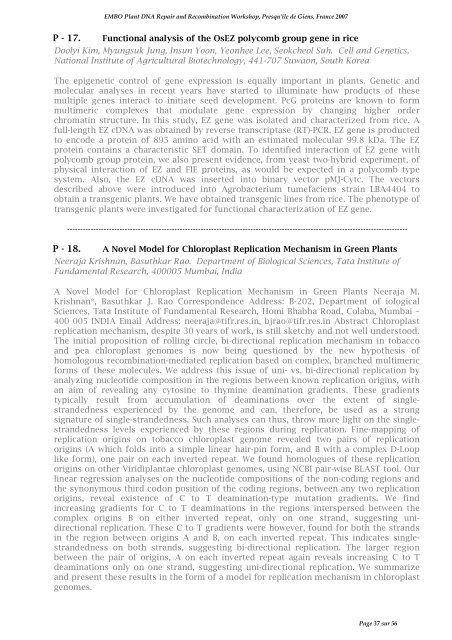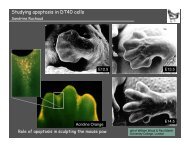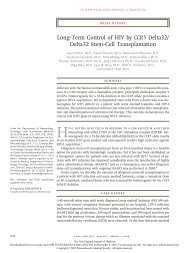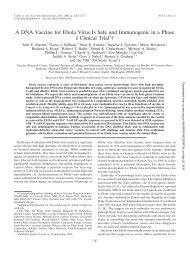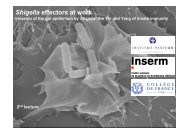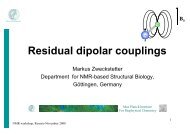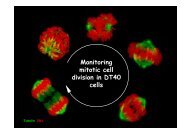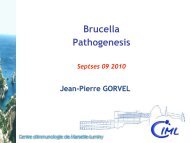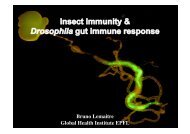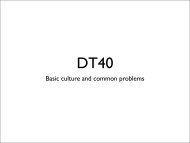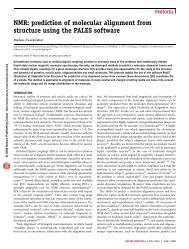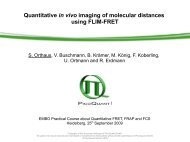pdf file - Events - EMBO
pdf file - Events - EMBO
pdf file - Events - EMBO
You also want an ePaper? Increase the reach of your titles
YUMPU automatically turns print PDFs into web optimized ePapers that Google loves.
<strong>EMBO</strong> Plant DNA Repair and Recombination Workshop, Presqu'île de Giens, France 2007<br />
P - 17. Functional analysis of the OsEZ polycomb group gene in rice<br />
Doolyi Kim, Myungsuk Jung, Insun Yoon, Yeonhee Lee, Seokcheol Suh. Cell and Genetics,<br />
National Institute of Agricultural Biotechnology, 441-707 Suwaon, South Korea<br />
The epigenetic control of gene expression is equally important in plants. Genetic and<br />
molecular analyses in recent years have started to illuminate how products of these<br />
multiple genes interact to initiate seed development. PcG proteins are known to form<br />
multimeric complexes that modulate gene expression by changing higher order<br />
chromatin structure. In this study, EZ gene was isolated and characterized from rice. A<br />
full-length EZ cDNA was obtained by reverse transcriptase (RT)-PCR. EZ gene is producted<br />
to encode a protein of 895 amino acid with an estimated molecular 99.8 kDa. The EZ<br />
protein contains a characteristic SET domain. To identified interaction of EZ gene with<br />
polycomb group protein, we also present evidence, from yeast two-hybrid experiment, of<br />
physical interaction of EZ and FIE proteins, as would be expected in a polycomb type<br />
system. Also, the EZ cDNA was inserted into binary vector pMJ-Cytc. The vectors<br />
described above were introduced into Agrobacterium tumefaciens strain LBA4404 to<br />
obtain a transgenic plants. We have obtained transgenic lines from rice. The phenotype of<br />
transgenic plants were investigated for functional characterization of EZ gene.<br />
----------------------------------------------------------------------------------------------------------------------------------<br />
P - 18. A Novel Model for Chloroplast Replication Mechanism in Green Plants<br />
Neeraja Krishnan, Basuthkar Rao. Department of Biological Sciences, Tata Institute of<br />
Fundamental Research, 400005 Mumbai, India<br />
A Novel Model for Chloroplast Replication Mechanism in Green Plants Neeraja M.<br />
Krishnan*, Basuthkar J. Rao Correspondence Address: B-202, Department of iological<br />
Sciences, Tata Institute of Fundamental Research, Homi Bhabha Road, Colaba, Mumbai –<br />
400 005 INDIA Email Address: neeraja@tifr.res.in, bjrao@tifr.res.in Abstract Chloroplast<br />
replication mechanism, despite 30 years of work, is still sketchy and not well understood.<br />
The initial proposition of rolling circle, bi-directional replication mechanism in tobacco<br />
and pea chloroplast genomes is now being questioned by the new hypothesis of<br />
homologous recombination-mediated replication based on complex, branched multimeric<br />
forms of these molecules. We address this issue of uni- vs. bi-directional replication by<br />
analyzing nucleotide composition in the regions between known replication origins, with<br />
an aim of revealing any cytosine to thymine deamination gradients. These gradients<br />
typically result from accumulation of deaminations over the extent of singlestrandedness<br />
experienced by the genome and can, therefore, be used as a strong<br />
signature of single-strandedness. Such analyses can thus, throw more light on the singlestrandedness<br />
levels experienced by these regions during replication. Fine-mapping of<br />
replication origins on tobacco chloroplast genome revealed two pairs of replication<br />
origins (A which folds into a simple linear hair-pin form, and B with a complex D-Loop<br />
like form), one pair on each inverted repeat. We found homologues of these replication<br />
origins on other Viridiplantae chloroplast genomes, using NCBI pair-wise BLAST tool. Our<br />
linear regression analyses on the nucleotide compositions of the non-coding regions and<br />
the synonymous third codon position of the coding regions, between any two replication<br />
origins, reveal existence of C to T deamination-type mutation gradients. We find<br />
increasing gradients for C to T deaminations in the regions interspersed between the<br />
complex origins B on either inverted repeat, only on one strand, suggesting unidirectional<br />
replication. These C to T gradients were however, found for both the strands<br />
in the region between origins A and B, on each inverted repeat. This indicates singlestrandedness<br />
on both strands, suggesting bi-directional replication. The larger region<br />
between the pair of origins, A on each inverted repeat again reveals increasing C to T<br />
deaminations only on one strand, suggesting uni-directional replication. We summarize<br />
and present these results in the form of a model for replication mechanism in chloroplast<br />
genomes.<br />
Page 37 sur 56


